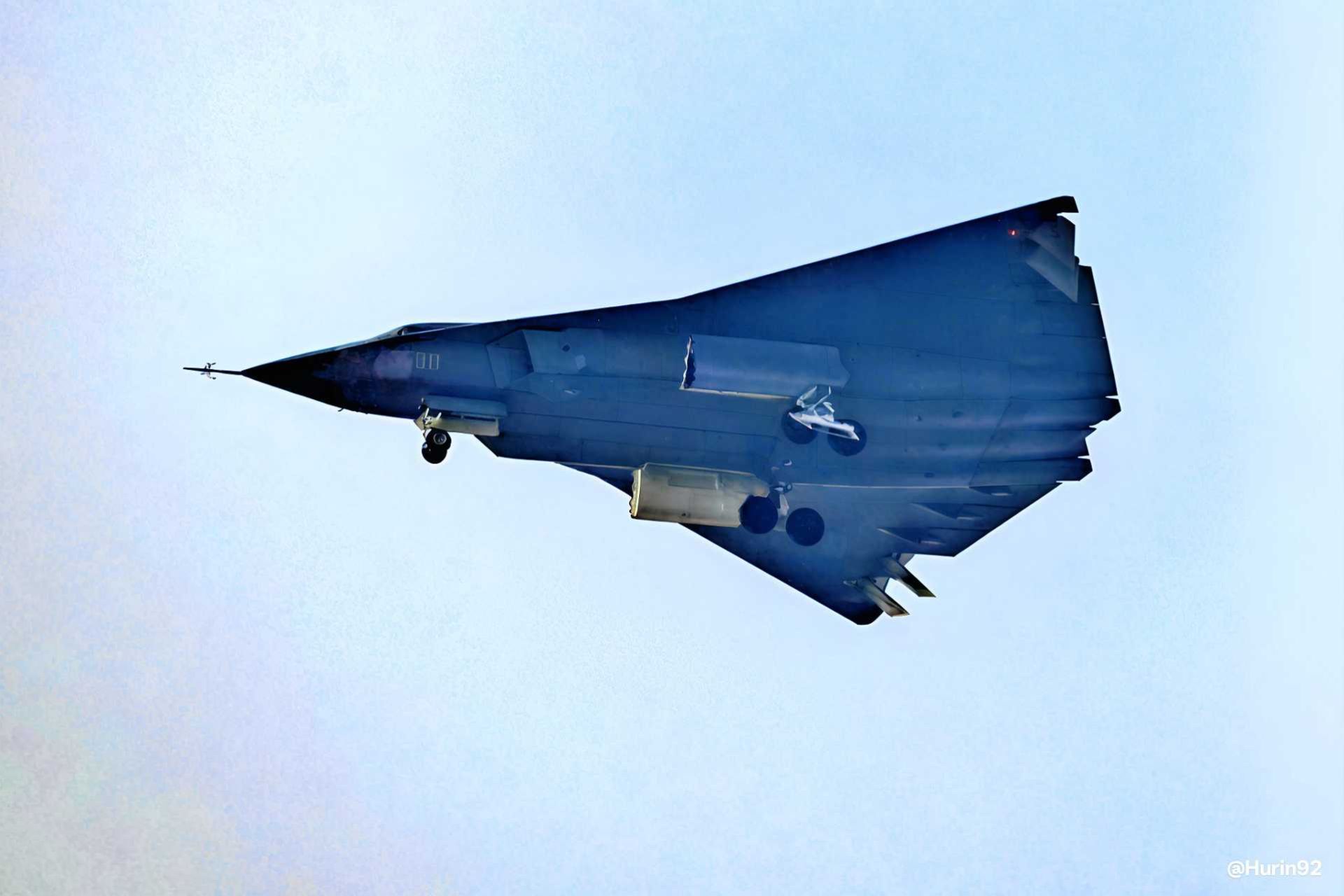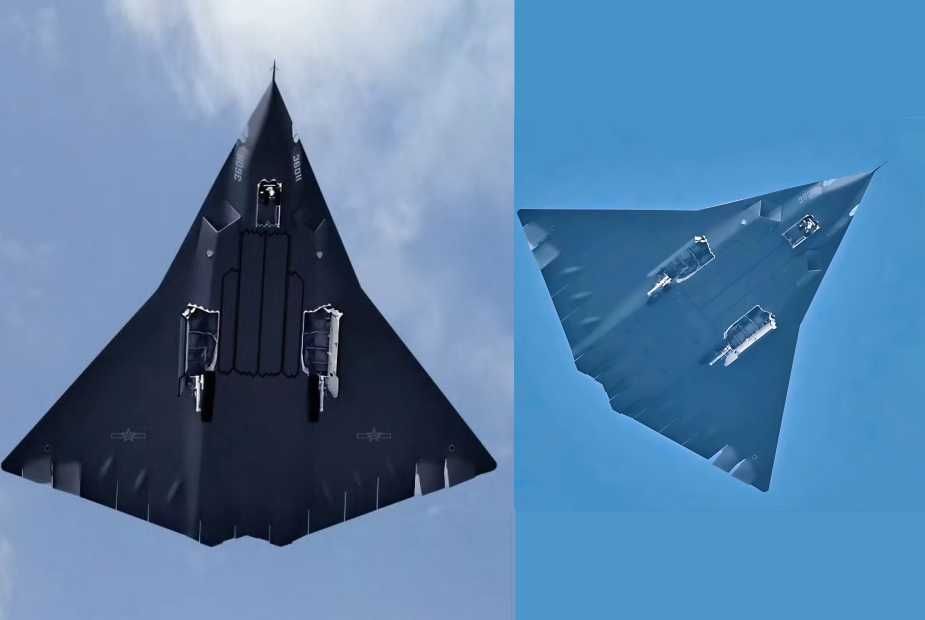Breaking News
Breaking News: Exclusive Secret Combat Capabilities of China’s New Chengdu J-36 Stealth Fighter Jet Unveiled.
Analysis by the Army Recognition editorial team reveals exclusive insights into the secret technical details and combat capabilities of China’s Chengdu J-36, a next-generation stealth fighter currently under development by the Chengdu Aircraft Industry Group (CAIC). On December 26, 2024, local residents near Chengdu, Sichuan, captured video footage of a tailless aircraft conducting a test flight.
Follow Army Recognition on Google News at this link

China's Chengdu J-36 stealth fighter captured during its first flight test near Chengdu, Sichuan, on December 26, 2024. (Picture source: China Social Network)
Bearing the serial number 36011, this mysterious aircraft has sparked global intrigue as it appears to embody the hallmarks of a sixth-generation fighter jet. Boasting advanced stealth technology, exceptional performance, and versatile combat capabilities, the J-36 represents a significant leap forward in China’s military aviation, signaling its ambition to redefine air combat and challenge global competitors on the battlefield.
The J-36 is distinguished by its bold tailless, delta-wing configuration, marking a substantial departure from traditional fighter jet designs. This innovative layout eliminates vertical stabilizers, significantly reducing the aircraft’s radar cross-section and enhancing its stealth capabilities. The tailless design is supported by advanced fly-by-wire flight control systems, which replace the stability functions traditionally provided by tailplanes with computer-assisted control surfaces. This not only ensures stability and maneuverability but also reduces drag, enhancing fuel efficiency and operational range. These features make the J-36 well-suited for long-duration missions and high-speed engagements. Additionally, its delta-wing shape contributes to exceptional maneuverability at high speeds, a critical attribute for modern air combat.
The air intake configuration of the J-36 further highlights its advanced design. The aircraft features intakes positioned on top of the fuselage and along the sides, suggesting the presence of a unique tri-engine configuration. This three-engine setup, reportedly incorporating advanced ACE engines, provides increased thrust, enhanced maneuverability, and the ability to carry heavier payloads. With this configuration, the J-36 is capable of achieving a maximum envelope speed of Mach 2.5, making it a high-speed platform suitable for air superiority and strike missions. The tri-engine design also ensures improved reliability and fuel efficiency, allowing the aircraft to sustain extended operations without sacrificing performance.
The dimensions of the J-36 are equally impressive. Measuring 22.5 m in length, with a wingspan of 24 m and a wing area of 248 square meters, the aircraft is larger than many fifth-generation fighters, offering additional internal space for weapons and advanced avionics. The J-36’s Maximum Take-Off Weight (MTOW) of 55 tons underscores its capacity to carry a significant payload, including advanced weapon systems and additional fuel for long-range missions. The estimated combat radius of approximately 3,000 kilometers further demonstrates its ability to operate effectively in extended-range scenarios, making it a critical asset in regions like the Indo-Pacific, where operational reach is paramount.
The Chengdu J-36 is expected to feature a range of advanced technologies, positioning it as a highly capable fighter for future combat scenarios. One of its most significant advancements is its propulsion system, which is believed to consist of next-generation WS engines, potentially upgraded versions of the WS-19. These engines are designed to deliver enhanced thrust and fuel efficiency, crucial for both high-speed performance and long-range missions. The inclusion of these engines ensures the J-36 is versatile enough for various mission types, ranging from air superiority operations to precision strike missions against ground and naval targets.
Stealth remains a defining characteristic of the J-36. Its fuselage is optimized for low observability through the use of radar-absorbing materials and advanced shaping techniques. The smooth contours and angular surfaces of the aircraft work in tandem to reduce radar detection, enabling it to operate in contested environments with a reduced risk of being tracked or targeted. These stealth features are designed to rival or surpass those of the U.S. F-22 and F-35, ensuring the J-36 can engage in high-stakes combat with minimal exposure to enemy radar systems.
The avionics onboard the J-36 are equally sophisticated. The aircraft is expected to be equipped with an Active Electronically Scanned Array (AESA) radar system, a critical component for detecting and tracking targets at long ranges. Additionally, the integration of electro-optical targeting systems (EOTS) will allow the J-36 to accurately engage both air-to-air and air-to-ground targets. These systems will enable the aircraft to track multiple targets simultaneously and operate effectively in a variety of environmental and electronic warfare conditions, making it highly versatile in combat scenarios. The avionics suite also likely includes advanced electronic warfare systems, ensuring the J-36 can counter electronic countermeasures and maintain its operational effectiveness in hostile environments.

The bottom view of the Chengdu J-36 reveals its sleek design and internal weapons bays, enabling the stealth fighter to carry a versatile and powerful payload while maintaining a low radar cross-section. (Picture source China Social Network)
In terms of armament, the J-36 is expected to carry a versatile and powerful payload, stored in internal weapons bays to maintain its stealth profile. These bays will likely accommodate a range of air-to-air and air-to-ground munitions, making the J-36 a multi-role fighter capable of excelling in various combat roles. The anticipated loadout includes two YJ-12 supersonic anti-ship missiles, enhancing the aircraft’s maritime strike capabilities, as well as four PL-15 long-range radar-guided air-to-air missiles, which are designed to engage enemy aircraft at extended ranges. Additionally, the J-36 may carry eight PL-17 missiles, advanced long-range weapons capable of targeting high-value aerial assets such as AWACS or refueling tankers. This diverse arsenal underscores the J-36’s ability to dominate in both air superiority and strike missions, providing a significant edge in modern warfare.
The development of the Chengdu J-36 represents a critical milestone in China’s military aviation program, particularly as the nation seeks to compete with the most advanced fighters in the world, including the U.S. F-35 and F-22. The J-36 is expected to play a pivotal role in air superiority and power projection, leveraging its advanced stealth, high-speed performance, and versatile payload capabilities. Its development comes at a time when China is expanding its influence and military capabilities, particularly in the Indo-Pacific region. As the People’s Liberation Army Air Force (PLAAF) continues to modernize, the J-36 is likely to form a core component of its next-generation fleet, complementing existing platforms such as the J-20 and J-35. Together, these aircraft will provide China with a robust and flexible air combat capability, enabling it to defend its strategic interests both domestically and internationally.
The Chengdu J-36 is not just a technological advancement; it is a strategic statement. With its innovative tailless design, advanced avionics, stealth features, and formidable weapon systems, the J-36 is set to become a cornerstone of China’s air combat arsenal. As additional details about its capabilities emerge, the J-36 underscores China’s determination to reshape the global balance of air power and secure its place as a leader in next-generation military aviation.


























